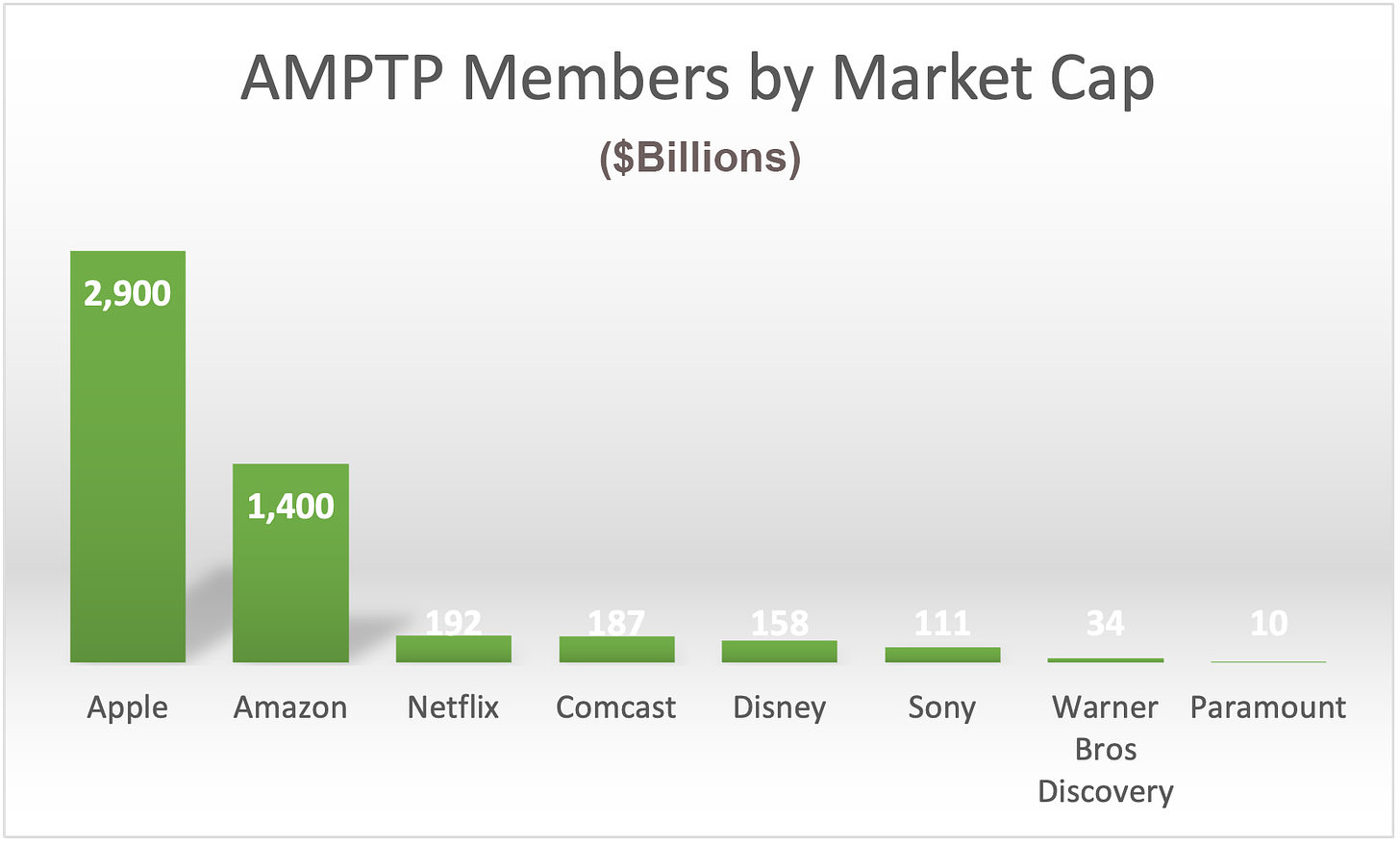The organization on the other side of the negotiating table from the striking writers and actors is the AMPTP, but how can one organization represent studios with such divergent interests?
The Alliance of Motion Picture and Television Producers (AMPTP) is a mysterious Hollywood trade association. Its website contains no list of member organizations: just some technical documents, a contact form, and links to a collection of terse press releases.
The association’s president, Carol Lombardini, has a page on the AMPTP site that you can find via diligent Googling, but there is no way to navigate to that page directly, the copyright date at the bottom of the page is 2010, and most of the links on that page are broken. The website lights are on but nobody’s home.
AMPTP is the organization on the other side of the negotiating table from the Writers Guild and the Actors Guild that are both on strike. In contrast to AMPTP, the websites of the other guilds overflow with useful information.
AMPTP’s reticence is important because the interests of its different members (the ones we know about) don’t seem to align, which is one reason why the negotiations aren’t going anywhere.
A Wikipedia page has a partial list of AMPTP members: Amazon, Apple, Comcast, Disney, Netflix, Paramount, Sony, and Warner Bros. Discovery (WBD).
Put simply, it’s ridiculous to talk about Amazon, Apple, Comcast, and Sony in the same breath as Disney, Netflix, Paramount, and WBD.
Apple and Amazon have entertainment as tiny parts of their overall businesses. AppleTV+, and Amazon’s Prime, FreeVee, and MGM don’t have to be profitable in order to drive profits elsewhere in those businesses. For example, Prime subscribers buy nearly three times more than non-subscribers each month, so if Amazon’s video offering attracts and keeps subscribers then it pays for itself.
Comcast owns Universal and NBC, but its core offering is communications: cable, internet, and telephone service. Sony makes more money selling PlayStations and other electronics than entertainment. Disney, WBD, and Paramount are classic Hollywood studios. While Netflix operates like a classic studio in some ways, its status as an almost pure streamer puts it in a category of its own.
A few issues back I wrote about overfocusing from the audience perspective: it’s easier to talk about the content of experiences than the context of those experiences—even though frequently it’s the context that makes an experience good or memorable.
Overfocusing is also a strategic issue: we want to create head-to-head comparisons between things in order to make sense of the world, but doing so can oversimplify, rendering invisible important differences among the things you’re comparing.
That is what’s happening with the AMPTP members and the Hollywood strikes.
Here’s a market capitalization chart (in billions) for each of the AMPTP members at market close on Friday, August 4 via Yahoo! Finance:

At the far right, Paramount closed with a market cap of $10 Billion. At the far left, Apple closed at $2.9 Trillion. From a revenue perspective alone it’s hard to see how the players are a gathering of equals inside the Sherman Oaks, California conference room at AMPTP headquarters where conversations are taking place.
The AMPTP members interests also fail to align in other ways. Here’s a chart of the different endeavors of the member companies:

Caveats:
- Apple, Amazon, and Netflix are all invested in AI, although in different ways. Netflix primarily uses AI for its “what to watch next” recommendation algorithms. Amazon has Alexa. Apple has Siri and has quietly been investing billions into R&D around Generative AI (like OpenAI’s ChatGPT).
- Comcast’s hardware is cable boxes and modems—different than the consumer electronics Apple, Sony, and Amazon sell.
- All the members are committed to releasing movies theatrically, but Amazon, Apple, and Netflix do limited releases in Los Angeles and New York in order to qualify for awards so that they can promote those movies for streaming soon after. Moviegoers at the Great Lakes Cinema 7 in Okoboji, Iowa will not be seeing Ridley Scott’s upcoming Napoleon movie (AppleTV+) or similar offerings from Amazon and Netflix anytime soon.
- Sony does not have a general streaming service, but it owns Crunchyroll, the dominant distributor of anime.
The above chart of AMPTP member endeavors is already complicated, but it’s still an oversimplification of the total entertainment ecosystem. Alphabet (Google) is not on the chart because it’s not a member, but YouTube is a dominant streaming video platform that also has a traditional “replace cable” TV offering. Meta is also not part of AMPTP, but a lot of streaming video happens on its Facebook and Instagram platforms. For Gen Z, TikTok is the most popular streaming platform, but TikTok is also not part of AMPTP.
Amazon and Apple are going to be cautious about signing any agreement that limits their ability to use AI in any way, particularly a way that might constrain their non-entertainment activities. Apple, for example, wants people to make movies on iPhones. If a generative AI can help users to do that, then it’s not going to stop them.
Since the striking actors and writers are making more noise than the studios, it’s easy to overfocus and miss the lack of alignment on the AMPTP side.
Leave a Reply